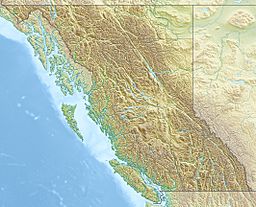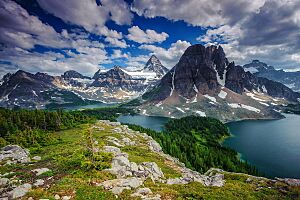Sunburst Peaks facts for kids
Quick facts for kids Sunburst Peaks |
|
|---|---|

Sunburst Peaks centered with Mount Assiniboine behind left
|
|
| Highest point | |
| Elevation | 2,849 m (9,347 ft) |
| Prominence | 79 m (259 ft) |
| Parent peak | Wedgwood Peak (3024 m) |
| Geography | |
| Location | Mount Assiniboine Provincial Park British Columbia, Canada |
| Parent range | Canadian Rockies |
| Topo map | NTS 82J13 |
| Geology | |
| Age of rock | Cambrian |
| Type of rock | sedimentary rock |
| Climbing | |
| First ascent | 1910 T.G. Longstaff, Katherine Longstaff, Rudolph Aemmer |
| Easiest route | Scrambling |
Sunburst Peaks is a group of mountain tops that stand tall at 2,849 meters (about 9,347 feet) high. You can find them in Mount Assiniboine Provincial Park, which is part of the amazing Canadian Rockies in British Columbia, Canada. The closest taller mountain is Wedgwood Peak, which is just 1 kilometer (about 0.6 miles) to the south. These peaks are located right next to Sunburst Lake, west of Lake Magog, and south of Cerulean Lake, making them a beautiful part of the park's landscape.
Contents
Exploring Sunburst Peaks: A Mountain's Story
Sunburst Peaks is not just one peak, but actually three mountain tops that are very close together. They are a popular spot for adventurers who love to explore the Canadian Rockies.
Who First Climbed Sunburst Peaks?
The very first time someone successfully climbed one of these peaks was in 1910. A woman named Katherine Longstaff and her brother, Dr. Tom Longstaff, made the climb. They had a guide named Rudolph Aemmer who helped them reach the top safely.
How Sunburst Peaks Got Its Name
The mountain was first called "Sunburst Peak" in 1953. It got this name from Sunburst Lake, which is nearby. The lake itself was named by a group called the Interprovincial Boundary Survey. Later, on February 15, 1983, the official name was changed to "Sunburst Peaks" (plural). This change was made by the Geographical Names Board of Canada to show that the name actually referred to all three peaks, not just one.
What Are Mountains Made Of? The Geology of Sunburst Peaks
Sunburst Peaks is made of a type of rock called sedimentary rock. This kind of rock forms when tiny bits of sand, mud, and other materials settle at the bottom of ancient seas over millions of years. These layers get pressed together and turn into solid rock.
How Mountains Are Formed
The sedimentary rock that makes up Sunburst Peaks was laid down during a very old time period called the Cambrian period. Back then, this area was covered by shallow seas. Much later, during a huge event called the Laramide orogeny, these rocks were pushed up and folded. This massive movement of the Earth's crust created the tall mountains we see today, including Sunburst Peaks.
Weather Around Sunburst Peaks
The weather at Sunburst Peaks is part of a subarctic climate zone. This means that winters are very cold and snowy, while summers are mild. Temperatures can often drop below -20° Celsius (which is -4° Fahrenheit). With the wind, it can feel even colder, sometimes below -30° Celsius (-22° Fahrenheit)! The snow and rain that fall on the peaks eventually melt and flow into the Mitchell River.




